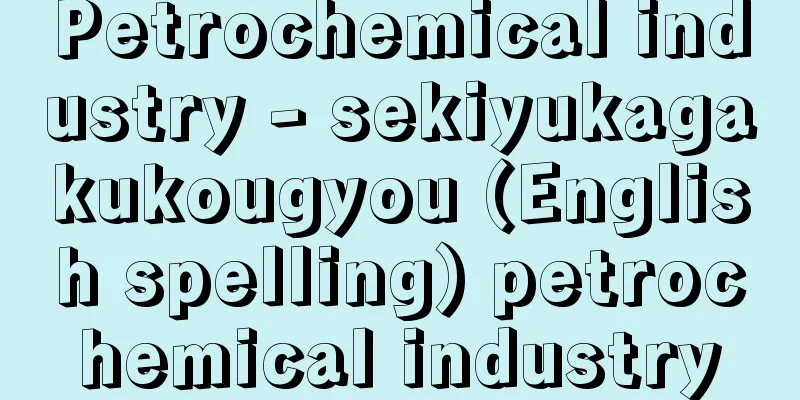Petrochemical industry - sekiyukagakukougyou (English spelling) petrochemical industry

|
The petrochemical industry is a chemical industry that uses petroleum or natural gas as raw materials and aims to synthesize chemical products other than petroleum products such as fuel oil, and the products it produces are called petrochemicals. The petrochemical industry occupies an extremely important position as a core industry in modern advanced industrial countries. Its final products are diverse, ranging from polymer products such as plastics, synthetic fibers, and synthetic rubber, to synthetic detergents (surfactants), organic solvents, dyes, pesticides, and pharmaceuticals, and the production of various monomers, intermediates, and other materials required for the synthesis of these products is at the heart of the petrochemical industry. [Hara Nobuyoshi] The significance and development history of the petrochemical industryUntil World War II, coal was the largest raw material in the chemical industry, but after the war, in parallel with the energy shift from coal to oil, the main raw materials in the chemical industry also shifted to oil and natural gas, and the petrochemical industry developed rapidly. Originally, many organic chemical products can be considered to be derivatives of hydrocarbons in a broad sense, and natural gas and oil, which are naturally occurring gaseous and liquid hydrocarbons, are far more advantageous as chemical industry raw materials in principle and in terms of ease of handling than coal, which is a complex polymer solid substance. After the war, the world's largest oil fields were developed in the Middle East, and oil became available in large quantities at low cost in many countries, so the shift from coal to oil as a raw material was a very natural progression. The history of the development of the petrochemical industry is closely related to the development of gasoline production methods. In the first half of the 20th century, the demand for gasoline increased dramatically due to the development of automobiles and aircraft, and the production of cracked gasoline became popular, especially from the 1920s, due to a shortage of gasoline produced only by distillation of crude oil (straight-run gasoline) and the demand for higher octane numbers. At that time, non-catalytic thermal cracking of heavy petroleum fractions was carried out, and the by-product cracked gas contained large amounts of low-molecular olefins such as ethylene, propylene, and butylene. In the United States, which had a large capacity for producing cracked gasoline, the idea of using it as a synthetic chemical raw material arose. Historically, the first time was in 1920, when Standard Oil Company (New Jersey) began synthesizing 2-propanol (isopropyl alcohol) by hydrating propylene in the cracked gas. Later, in the United States, the ethylene in the cracked gas was also used as a synthetic raw material for ethylene oxide, styrene, ethanol (ethyl alcohol), and other products. Thus, before World War II, the petrochemical industry was born in the United States with the aim of utilizing petroleum refining by-products, but after the war it developed into the modern petrochemical industry, which actively uses petroleum or natural gas itself as starting materials. The background to this is the progress of postwar catalytic chemistry, organic synthesis chemistry, and polymer chemistry, but the emergence of high-pressure polyethylene can be seen as a particularly major motivator. High-pressure polyethylene was invented in the UK before World War II, but during the war it was mainly produced in the US for military use, such as high-frequency insulators for Allied radars. After the war, this excellent new plastic became the largest target product for the chemical industry in each country. Other important chemical products include ethylene oxide, styrene, and vinyl chloride. In the early days of polyethylene production, ethylene in by-product cracking gas could be used, but this situation changed dramatically after the war. This is because the cracking gasoline production method progressed to the catalytic cracking method, which aimed to increase the octane number. In this method, based on the reaction mechanism, the by-product cracking gas contains propylene and butylene, but almost no ethylene. This created the need to produce ethylene separately, and in the US it was produced by cracking (dehydrogenating) ethane in abundant wet natural gas, while in Europe and later Japan it was mainly produced by thermal cracking of naphtha. In particular, naphtha cracking produces not only the main product ethylene, but also lower olefins such as propylene, butylene, and butadiene, and aromatic hydrocarbons such as benzene, toluene, and xylene (BTX). Naturally, these are used in a comprehensive manner. In recent years, in the United States, due to the reduction in natural gas production, naphtha and diesel cracking have been used to make up for the shortage of ethylene and propylene. Meanwhile, due to the improvement in the performance of automobile engines after the war, the straight-run gasoline obtained by distillation of crude oil no longer qualifies as gasoline due to its insufficient octane number, and it has been downgraded to naphtha. This catalytic reforming method has led to the development of high-octane reformed gasoline rich in aromatic hydrocarbons. At the same time, this method has been applied to the production of BTX as a raw material for the chemical industry. In addition, the chemical industry has also developed by steam transforming natural gas and petroleum fractions into synthetic gas (hydrogen, carbon monoxide), which is used as a synthetic raw material. In this way, basic raw materials could be obtained from petroleum and natural gas in a variety of ways, and new, effective catalysts were discovered one after another. This led to significant progress in the development of new manufacturing processes for monomers and intermediates needed for various chemical industries, including the polymer industry, and promoted the development of the petrochemical industry. The petrochemical industry was also greatly affected by the soaring prices of raw materials caused by the first (1973) and second oil crises (1979), but oil is an irreplaceable commodity not so much as an energy source but as a raw material for the chemical industry, and the petrochemical industry remains the backbone of the chemical industry. Furthermore, Japan's petroleum industry only restarted in 1949, and it was later than the United States and European countries in entering the petrochemical industry, starting in 1957, but it is now the second largest petrochemical country after the United States. [Hara Nobuyoshi] Basic raw materials for the petrochemical industryThe most important basic raw materials used in the petrochemical industry are as outlined in the previous section, but they can be broadly divided into three categories: lower olefins, lower aromatic hydrocarbons, and synthetic gas. [Hara Nobuyoshi] Lower OlefinsLower olefins such as ethylene, propylene, and butylene are important monomers in themselves, and their polymerization produces polyolefins, synthetic rubber, and other products. At the same time, they are also the raw materials for the synthesis of many aliphatic monomers and intermediates. These olefins are separated and refined by low-temperature precision distillation of cracked gas obtained by thermal cracking of petroleum fractions such as naphtha. Naphtha cracking uses high temperature and short residence time conditions, which produce ethylene, which is in high demand, as the main product. In the United States, where wet natural gas is abundant, the main method is high-temperature thermal cracking of ethane, which is the most favorable method for producing ethylene. In addition, the cracked gas produced as a by-product in the production of catalytic cracked gasoline is a source of propylene and butylene. Butadiene, which is an important raw material for synthetic rubber, is separated and refined by extractive distillation of the C4 fraction produced by naphtha cracking, but many countries around the world synthesize butadiene by dehydrogenating butane and butylene. Isoprene is also important as a raw material for synthetic rubber, and is separated and refined by extractive distillation of the C5 fraction produced by naphtha cracking, and is also synthesized by various methods. [Hara Nobuyoshi] Lower aromatic hydrocarbonsBenzene, toluene, and xylene (BTX) are the base raw materials for the synthesis of various aromatic compounds, which are separated by solvent extraction from aromatic gasoline, a by-product of naphtha cracking, or from catalytic reforming gasoline of naphtha. When reforming gasoline is the source of BTX, it is called reformate. Xylene is obtained as a mixture of four isomers: o-xylene, m-xylene, p-xylene, and ethylbenzene. Of these, o-xylene and ethylbenzene can be separated by ultra-precision distillation, but m- and p-xylene, which have similar boiling points, cannot be separated by distillation. They are separated by low-temperature crystallization separation, taking advantage of the high melting point of p-xylene (13.3°C), or by molecular sieving with zeolite. However, the xylene with the greatest demand is p-xylene, which is used as a raw material for terephthalic acid, and the most common method is to isomerize other xylene isomers to p-xylene, which is then used as the main product. On the other hand, toluene, which is in relatively low demand among BTX, is converted into benzene by a demethylation process, or into benzene and xylene by a disproportionation process. [Hara Nobuyoshi] SyngasSynthetic gas is a mixture of hydrogen and carbon monoxide, and is obtained by steam conversion of natural gas or petroleum fractions. Synthetic gas was originally named as the feed gas for methanol synthesis, but it is also important as a hydrogen source for ammonia synthesis, and as a carbon monoxide and hydrogen source for oxo synthesis. Methane is also used directly as a raw material for the synthesis of hydrogen cyanide, methane chloride, carbon disulfide, etc. There was a time when acetylene was produced by high-temperature pyrolysis of natural gas and naphtha, but nowadays the raw material has mostly been switched from acetylene to olefins, and the production of petroleum acetylene has almost disappeared. Ethylene contained in coke oven gas from the steel industry is recovered and separated and used as a raw material for the synthesis of styrene, etc. [Hara Nobuyoshi] PetrochemicalsThere are a huge number of petrochemical products, but of these, ethylene-based products have the greatest uses and demand. [Hara Nobuyoshi] Ethylene-based productsThe main primary products are polyethylene, vinyl chloride monomer, ethylene oxide, styrene monomer, acetaldehyde, and ethanol, with polyethylene accounting for approximately 42% of ethylene demand in Japan (2007). These primary products are further processed into acetic acid, vinyl acetate, ethylene glycol, and other products, which ultimately become many chemical products, including plastics such as polyethylene, polystyrene, and polyvinyl chloride, polyester fibers, vinylon, synthetic rubber, and synthetic detergents. [Hara Nobuyoshi] Propylene-based productsThe next most in demand after ethylene are propylene-based products, with major primary products being polypropylene, acrylonitrile, propylene oxide, 2-propanol, butanol, 2-ethylhexanol (octanol), acetone, acrylic acid, and glycerin, with polypropylene and acrylonitrile in particular accounting for approximately 60% of Japan's propylene demand (2007). These primary products are ultimately made into products such as polypropylene, acrylic resin, epoxy resin and other plastics, acrylic fibers, synthetic rubber NBR, various organic solvents, and plasticizers. [Hara Nobuyoshi] Butylene and butadiene productsButylene and isobutylene are used to produce solvents such as butanol and methyl ethyl ketone, and maleic anhydride, a raw material for alkyd resins, while butadiene is used as the main raw material for various synthetic rubbers. [Hara Nobuyoshi] Benzene-based productsThe main primary products derived from benzene are phenol, styrene monomer, caprolactam, adipic acid, hexamethylenediamine, maleic anhydride, etc., which are ultimately made into plastics such as phenolic resins, polystyrene, alkyd resins, epoxy resins, and products such as nylon 6 and nylon 6·6. [Hara Nobuyoshi] Toluene and xylene productsA typical primary product from toluene is tolylene diisocyanate, which is the main raw material for polyurethane. Various phthalic acids are produced from the three isomers of xylene, and terephthalic acid in particular is used as the main raw material for polyester fibers. [Hara Nobuyoshi] Methane-based productsFormaldehyde is synthesized from synthetic gas via methanol, which is the raw material for various thermosetting resins. In recent years, acetic acid has been synthesized from methanol and carbon monoxide, and this is the main method of acetic acid production, but C1 chemistry, which uses methanol and carbon monoxide as synthetic raw materials, has also been developed. Meanwhile, hydrogen is produced by the reaction of water vapor with carbon monoxide (CO conversion reaction), and synthesis gas is also the most effective method for industrially producing hydrogen. In the petrochemical industry, ammonia is synthesized in an integrated manner using naphtha, water, and air as raw materials. Sulfur recovered from petroleum is also used as a raw material for the production of sulfuric acid. In this way, petrochemical products are not just organic chemical products, but also include inorganic chemical products such as ammonia, chemical fertilizers, and sulfuric acid, and it is no exaggeration to say that petrochemical products account for the majority of the materials necessary for modern human life. The development of the petrochemical industry can be said to have had an enormous impact on enriching the lives of human beings. [Hara Nobuyoshi] Characteristics of the petrochemical industryThe petrochemical industry, like the petroleum industry, is characterized by being a typical process industry. Because the raw materials are fluids, reactions, separation, purification, storage, etc. are all carried out in individual processes connected by pipes. The reaction conditions and material transfer in the plant, which is a combination of a series of these processes, are all automated by remote control, and products are continuously manufactured from the raw materials. In Japan, most of the basic raw materials for the petrochemical industry are supplied by naphtha cracking, and a large number of chemical products are derived from these raw materials. For this reason, one of the characteristics of the petrochemical industry is that many related chemical plants are concentrated in one area, centered around naphtha cracking centers directly connected to oil refineries, to form petrochemical complexes. Each of these chemical plants is directly connected to the naphtha cracking center by pipeline to receive the necessary basic raw materials and manufacture various petrochemical products. In addition, a thermal power plant directly connected to the refinery is installed within the complex, supplying electricity to the complex and the surrounding area. [Hara Nobuyoshi] Japan's Petrochemical IndustryJapan's petrochemical industry was pioneered in 1952 when Nippon Gas Chemical (now Mitsubishi Gas Chemical) began synthesizing methanol using natural gas from Niigata as a raw material, but the first petroleum-based product was Maruzen Oil (now Cosmo Oil) which began synthesizing 2-butanol from butylene in the by-product gas of petroleum catalytic cracking in 1957. In light of the importance of the petrochemical industry, the government decided in 1956 to develop it by acquiring the former military fuel depot sites in Yokkaichi, Iwakuni, and Tokuyama, and implementing a petrochemical industrialization plan to utilize these sites for the petrochemical industry. Based on this plan, between 1958 and 1959, the four pioneering companies Mitsui Petrochemical (now Mitsui Chemicals, Iwakuni), Sumitomo Chemical (now Sumitomo Chemical, Niihama), Mitsubishi Petrochemical (now Mitsubishi Chemical, Yokkaichi), and Nippon Petrochemical (now JXTG Energy, Kawasaki) began operations one after another, marking the start of the first comprehensive petrochemical industry. The scale of the petrochemical industry is generally compared by ethylene production capacity and ethylene demand, but at the time, the annual ethylene production capacity of a naphtha cracking unit was only 20,000 tons per unit, and 80,000 tons for the whole of Japan (1958). Thanks to initial government promotion measures, petroleum complexes were built one after another in various industrial regions, and at the same time, ethylene production capacity increased dramatically as naphtha cracking units became larger. In the 20 years leading up to 1978, 18 petrochemical complexes were completed in 10 regions: Kashima, Chiba, Kawasaki, Yokkaichi, Senboku-Sakai, Mizushima, Iwakuni-Otake, Tokuyama-Nanyo, Niihama, and Oita. Meanwhile, the ethylene production capacity of naphtha cracking plants increased year by year, from 100,000 tons (1965), to 200,000 tons (1966), to 300,000 tons (1968), and by 1978, 450,000-ton plants had appeared. As a result, the nominal ethylene production capacity of Japan as a whole reached approximately 6.35 million tons (second in the world after the United States). Japan's petrochemical industry was launched with the introduction of foreign technology, but domestic technology was gradually developed, and in recent years, technology exports to overseas have also increased. Japan's petrochemical industry grew rapidly during the high-growth period up until the oil crisis, but after the second oil crisis, growth stagnated due to the effects of rising naphtha prices and fluctuations in the yen exchange rate, and ethylene demand, which had reached about 4.8 million tons, often fell below 4 million tons. Due to structural recession caused by excess capacity, Japan's petrochemical industry entered a period of transition, with its international competitiveness and export capacity gradually declining, and the disposal of excess capacity led to a decline in the nominal production capacity of ethylene to 4.32 million tons (1985). However, as one of Japan's core industries, the petrochemical industry is important in supplying materials necessary for various industrial and consumer sectors, and the proportion of the petrochemical industry in Japan's chemical industry production value reached about 50% (1984). Since the 1990s, ethylene exports have increased due to the recovery of the Asian economy, and production volume has also increased, reaching an annual production capacity of 7.23 million tons in 2003 (6.155 million tons in 2017). [Hara Nobuyoshi] Oil Refining, Petrochemicals and Environmental IssuesThe 1960s, when Japan's economy achieved high growth, was also a time when environmental pollution and pollution problems became apparent. The heavy chemical industrialization that supported the high growth economy led to the creation of petrochemical complexes in various regions in addition to existing industrial zones. These were clusters of petrochemical, steel, and other factories with oil refineries at their core, and were the result of the pursuit of economic benefits from agglomerations using energy as a medium. The high concentration of resource- and energy-intensive industries inevitably leads to the concentrated generation of various types of waste, which, if released without proper treatment and disposal, can cause serious environmental pollution. A typical example was the air pollution in Yokkaichi, Mie Prefecture. In existing industrial areas, the main pollutant was soot and dust, but here it was mainly sulfur oxides. Crude oil imported to Japan contains a lot of sulfur, and the heavy oil produced from it contains even higher concentrations of sulfur, and its combustion releases large amounts of sulfur oxides into the atmosphere. The frequent occurrence of a chronic respiratory condition known as Yokkaichi asthma was believed to be caused by these sulfur oxides. To prevent this type of air pollution, legal regulations were established and strengthened, and various technological measures such as desulfurization were promoted, and today environmental standards for sulfur oxides are almost completely met in most areas. Meanwhile, around 1970, photochemical smog, a new type of complex pollution, began to be seen as a problem. Its causative substances are hydrocarbons emitted from oil refining processes and nitrogen oxides contained in automobile exhaust. To combat photochemical smog, measures were adopted to prevent and seal hydrocarbon leaks at oil refining plants and other facilities, and flue gas denitrification became widespread for removing nitrogen oxides. Automobiles began to be fitted with exhaust purification devices. As a result, the frequency of occurrence has decreased, but it has not yet been eradicated. Water pollution is also an environmental problem caused by oil refining and petrochemicals, but as a result of strengthened legal regulations and the advancement of technological measures, the water quality of seas and rivers, except for lakes and marshes, is improving. Factory wastewater is purified using oil-water separators, activated sludge treatment, activated carbon treatment, and other methods, and is released only after it meets effluent standards. In addition to the above, oil refineries and petrochemical plants are making efforts to set up green belts and reduce noise and vibration, and as with steel and other factories, consideration is being given not only to the physical conservation of the environment but also to harmony with the surrounding area, including the scenery. [Hiroo Tominaga] "Petrochemicals and Their Industries" by Yoshiro Morita and Suehiko Yoshitomi (1981, Shokodo) [Reference items] | | | | | | | | | | | | |Butadiene| |©Shogakukan "> Manufacture of basic raw materials for the petrochemical industry Source: Shogakukan Encyclopedia Nipponica About Encyclopedia Nipponica Information | Legend |
|
石油または天然ガスを原料とし、燃料油など本来の石油製品petroleum productを除く化学製品の合成を目的とする化学工業を石油化学工業といい、その製品を石油化学製品(ペトロケミカルスpetrochemicals)という。石油化学工業は現代先進工業諸国における基幹産業としてもっとも重要な地位を占める。その最終製品はプラスチック、合成繊維、合成ゴムなどの高分子製品をはじめ、合成洗剤(界面活性剤)、有機溶剤、染料、農薬、医薬など多岐にわたり、これらの合成に必要な各種単量体、中間体などの素材生産が、石油化学工業の中心となっている。 [原 伸宜] 石油化学工業の意義と発達史第二次世界大戦当時まで石炭が化学工業の最大の原料であったが、戦後石炭から石油へのエネルギー転換と並行して、化学工業の主原料も石油および天然ガスへ転換し、石油化学工業は急速な発展を遂げた。もともと有機化学製品の多くは、広義に炭化水素の誘導体とみなすことができ、天然産ガス状および液状炭化水素の天然ガスと石油は、複雑な高分子固体物質の石炭に比べ、原理的にも取扱いの容易さからも化学工業原料としてはるかに有利な条件をもつ。戦後中東地域に世界最大の油田が開発され、各国で石油を大量安価に入手できるようになったため、石炭から石油への原料転換はきわめて自然の成り行きであった。 石油化学工業発達の歴史は、ガソリン製造法の発展ときわめて関係が深い。20世紀前半に自動車、航空機の発達によりガソリン需要が激増し、原油の蒸留のみによるガソリン(直留ガソリン)の不足、オクタン価向上の要求などにより、とくに1920年代から分解ガソリンの製造が盛んになった。当時は石油重質留分の無触媒熱分解法が行われ、副生する分解ガス中には多量のエチレン、プロピレン、ブチレンなどの低級オレフィン類を含むため、分解ガソリン製造能力の大きいアメリカでは、これを合成化学原料に利用する考えがおこった。歴史的には1920年、スタンダード石油会社(ニュー・ジャージー)が分解ガス中のプロピレンの水和により2‐プロパノール(イソプロピルアルコール)の合成を開始したのが最初である。その後アメリカでは、分解ガス中のエチレンを酸化エチレン(エチレンオキシド)、スチレン、エタノール(エチルアルコール)などの合成原料に利用することも行われた。このように第二次世界大戦前、石油化学工業はアメリカで石油精製副生物の利用を目的として誕生したが、大戦後はむしろ石油または天然ガスそのものを積極的に出発原料として使用する現代の石油化学工業の形態に発展した。 その背景には戦後の触媒化学、有機合成化学、高分子化学の進歩があるが、とくに大きい動機になったものは高圧法ポリエチレンの出現にあるとみてよい。高圧法ポリエチレンは第二次世界大戦前イギリスで発明されたが、大戦中おもにアメリカで連合軍のレーダー用高周波絶縁体などもっぱら軍需用に生産された。戦後この優れた新プラスチックは、各国の化学工業で最大の目標製品となった。エチレン誘導体にはこのほか酸化エチレン、スチレン、塩化ビニルなど重要な化学製品が多い。初期のポリエチレン製造には、副生分解ガス中のエチレンが利用できたが、戦後はこの事情が一変した。これは、分解ガソリン製造法がさらにオクタン価向上を目的とした接触分解法に進歩したからである。この方法では反応機構に基づき、副生分解ガスにはプロピレン、ブチレンを含むが、エチレンはほとんど含まれていない。このためエチレンは別個に製造する必要を生じ、アメリカでは豊富な湿性天然ガス中のエタン分解(脱水素)により、またヨーロッパや後発の日本ではおもにナフサの熱分解により製造されるようになった。とくにナフサ分解では、主生成物のエチレンのほか、プロピレン、ブチレン、ブタジエンなどの低級オレフィン類やベンゼン・トルエン・キシレン(BTX)などの芳香族炭化水素が同時に生成する。これらは当然総合的に利用されることになる。近年アメリカでも天然ガスの減産により、ナフサや軽油分解によってエチレン、プロピレンの不足を補うようになっている。一方、戦後の自動車エンジンの性能向上により、原油の蒸留で得られる往時の直留ガソリンは、オクタン価不足のためもはやガソリンとしての資格を欠き、格下げしてナフサとよばれ、この接触改質法により芳香族炭化水素に富む高オクタン価改質ガソリンの製造が発達した。この方法は同時に化学工業原料としてのBTXの生産に応用されるようになった。また天然ガスや石油留分を水蒸気変成して合成ガス(水素、一酸化炭素)に変え、これを合成原料とする化学工業も進展した。このように石油、天然ガスから種々の方法で基礎原料が得られるとともに、有効な新触媒が続々と発見され、高分子工業など各化学工業に必要な単量体、中間体などの新しい製造プロセスの開発が著しく進展し、石油化学工業を発達させていった。 第一次(1973)および第二次石油危機(1979)による原料価格の高騰により、石油化学工業も大きい影響を受けたが、石油はエネルギー源としてよりも、むしろ化学工業原料としてかけがえのない物資であり、石油化学工業は依然として化学工業の基幹となっている。 なお、日本の石油工業は1949年(昭和24)に至ってようやく再開されたこともあり、石油化学工業への参入はアメリカ、ヨーロッパ各国に比べて後発で、1957年に開始されたが、現在ではアメリカに次ぐ規模をもつ石油化学工業国となっている。 [原 伸宜] 石油化学工業の基礎原料石油化学工業のもっとも主要な基礎原料の概要は前節に述べたとおりであるが、これを大別すると、低級オレフィン類、低級芳香族炭化水素、合成ガスの三つの系統になる。 [原 伸宜] 低級オレフィン類エチレン、プロピレン、ブチレンなどの低級オレフィン類は、それ自身重要な単量体で、その重合によりポリオレフィン、合成ゴムなどが製造され、同時に多くの脂肪族単量体、中間体の合成原料となる。これらのオレフィン類はナフサなど石油留分の熱分解で得られる分解ガスの低温精密蒸留により分離精製される。ナフサ分解では、とくに需要量の多いエチレンが主生成物となる高温、短滞留時間の条件が用いられる。湿性天然ガスが豊富なアメリカでは、エチレン生成にもっとも有利なエタンの高温熱分解を主としている。また、接触分解ガソリンの製造で副生する分解ガスは、プロピレン、ブチレン源となる。合成ゴム原料として重要なブタジエンは、ナフサ分解で生成するC4留分の抽出蒸留で分離精製されるが、世界的にはブタン、ブチレンの脱水素でブタジエンを合成する国も多い。イソプレンも合成ゴム原料として重要で、これもナフサ分解で生成するC5留分の抽出蒸留で分離精製され、また各種の方法で合成されている。 [原 伸宜] 低級芳香族炭化水素ベンゼン・トルエン・キシレン(BTX)は各種芳香族化合物の合成基礎原料であり、これらはナフサ分解で副生する芳香族性ガソリン、あるいはナフサの接触改質ガソリンから溶剤抽出によって分離される。改質ガソリンをBTX源とする場合、これをリフォーメトとよぶ。 キシレンはo(オルト)‐、m(メタ)‐、p(パラ)‐キシレンおよびエチルベンゼンの四異性体混合物として得られ、このうちo‐キシレンおよびエチルベンゼンは超精密蒸留によって分離できるが、沸点が近似しているm‐およびp‐キシレンは蒸留では分離できない。これらはp‐キシレンの高融点(13.3℃)を利用した低温結晶化分離、またはゼオライトによる分子ふるいによって分離される。しかしキシレン中もっとも需要が多いのはテレフタル酸原料のp‐キシレンで、他のキシレン異性体をp‐キシレンに異性化させ、これを主生成物とさせる方式が一般に行われている。 一方、BTXのうち比較的需要が少ないトルエンは、脱メチル法によりベンゼンとし、あるいは不均化法によりベンゼンとキシレンに転化させることも行われる。 [原 伸宜] 合成ガス合成ガスは水素、一酸化炭素の混合ガスをいい、天然ガスや石油留分の水蒸気変成法で得られる。もともと合成ガスはメタノール合成原料ガスとしてこの名があるが、アンモニア合成などに必要な水素源、オキソ合成に必要な一酸化炭素、水素源などとしても重要である。またメタンは直接、シアン化水素、塩化メタン類、二硫化炭素などの合成原料として使われる。このほか天然ガス、ナフサなどの高温熱分解によりアセチレンが製造された時期があるが、現在ではアセチレン系からオレフィン系への原料転換が多く、石油アセチレンの製造はほとんど消滅した。製鉄工業のコークス炉ガスに含まれるエチレンは、これを回収分離してスチレンなどの合成原料に利用される。 [原 伸宜] 石油化学製品石油化学製品の数はきわめて多いが、このうちもっとも多くの用途、需要をもつものはエチレン系製品である。 [原 伸宜] エチレン系製品ポリエチレン、塩化ビニルモノマー、酸化エチレン、スチレンモノマー、アセトアルデヒド、エタノールなどが主要な一次製品で、日本ではポリエチレンがエチレン需要の約42%(2007)を占める。これらの一次製品からさらに酢酸、酢酸ビニル、エチレングリコールなどがつくられ、最終的にはポリエチレン、ポリスチレン、ポリ塩化ビニルなどのプラスチック、ポリエステル繊維、ビニロン、合成ゴム、合成洗剤など多くの化学製品となる。 [原 伸宜] プロピレン系製品エチレンに次いで需要が多いのはプロピレン系製品で、ポリプロピレン、アクリロニトリル、酸化プロピレン、2‐プロパノール、ブタノール、2‐エチルヘキサノール(オクタノール)、アセトン、アクリル酸、グリセリンなどが主要な一次製品で、とくにポリプロピレンとアクリロニトリルが日本のプロピレン需要の約60%(2007)を占めている。これらの一次製品から最終的にポリプロピレン、アクリル樹脂、エポキシ樹脂などのプラスチック、アクリル系繊維、合成ゴムNBR、各種有機溶剤、可塑剤などの製品となる。 [原 伸宜] ブチレン系、ブタジエン系製品ブチレン、イソブチレンからは、ブタノール、メチルエチルケトンなどの溶剤やアルキド樹脂原料の無水マレイン酸などが製造され、ブタジエンは各種合成ゴムの主原料に用いられる。 [原 伸宜] ベンゼン系製品ベンゼンから誘導される主要な一次製品は、フェノール、スチレンモノマー、カプロラクタム、アジピン酸、ヘキサメチレンジアミン、無水マレイン酸などで、これらは最終的にフェノール樹脂、ポリスチレン、アルキド樹脂、エポキシ樹脂などのプラスチックや6‐ナイロン、6・6‐ナイロンなどの製品となる。 [原 伸宜] トルエン系、キシレン系製品トルエンからの一次製品としてはトリレンジイソシアナートが代表的で、これはポリウレタンの主原料である。キシレンの三異性体からは各種フタル酸が製造され、とくにテレフタル酸はポリエステル繊維の主原料に用いられる。 [原 伸宜] メタン系製品合成ガスからメタノールを経てホルムアルデヒドが合成され、これは各種熱硬化性樹脂の原料となる。また近年メタノールと一酸化炭素から酢酸が合成され、これが酢酸製造法の主力となっているが、このほかメタノールや一酸化炭素を合成原料とするシーワン(C1)化学が発展してきている。 一方、水蒸気と一酸化炭素との反応により(CO転化反応)さらに水素が生成し、合成ガスは同時に水素の工業的製造法としてもっとも有力な方法で、石油化学工業ではナフサ、水、空気を原料としてアンモニアを一貫方式で合成している。また、石油から回収される硫黄(いおう)は硫酸製造原料となる。このように石油化学製品は単に有機化学製品のみならず、アンモニア、化学肥料、硫酸などの無機化学製品に及び、現代の人間生活に必要な物資の大部分は石油化学製品が占めているといっても過言ではない。石油化学工業の発展は人類の生活を豊かにするうえで、きわめて大きい影響を与えたといえる。 [原 伸宜] 石油化学工業の特徴石油化学工業は石油工業と同様に、典型的な装置工業であることが特徴で、原料は流体であるため、反応、分離、精製、貯蔵などはすべてパイプで結ばれたそれぞれの装置内で行われる。これら一連の装置の組合せからなるプラントの反応条件の調整、物質移動などはすべて遠隔操作により自動化され、原料から連続的に製品が製造される。石油化学工業の基礎原料はわが国ではナフサ分解により大部分が供給され、この原料から誘導される化学製品はきわめて多い。このため石油製油所と直結するナフサ分解センターを中心に、多くの関連化学工場が一地域に集結して石油化学コンビナートを形成していることも、石油化学工業の一特徴である。これらの各化学工場はパイプラインによりナフサ分解センターと直結して必要な基礎原料を受け、各種の石油化学製品を製造する。またコンビナート内には製油所と直結する火力発電所が設けられ、コンビナートおよび周辺地域の電力を供給している。 [原 伸宜] 日本の石油化学工業日本の石油化学工業は1952年、日本瓦斯(ガス)化学(現、三菱(みつびし)瓦斯化学)が新潟の天然ガスを原料に用い、メタノールの合成を開始してその先鞭(せんべん)をつけたが、石油を原料としたものでは、1957年丸善石油(現、コスモ石油)が石油接触分解副生ガス中のブチレンから2‐ブタノールの合成を開始したのが最初である。政府は石油化学工業の重要性から、その育成のため、1956年に四日市(よっかいち)、岩国、徳山の旧軍燃料廠(しょう)跡を払い下げて石油化学工業に活用する石油化学企業化計画を決定した。この計画に基づき、1958~1959年にかけて、三井石油化学(現、三井化学。岩国)、住友化学工業(現、住友化学。新居浜(にいはま))、三菱油化(現、三菱ケミカル。四日市)、日本石油化学(現、JXTGエネルギー。川崎)の先発4社が相次いで操業に入り、初めて総合的な形態をもつ石油化学工業が始められた。石油化学工業の規模は一般にエチレン生産能力やエチレン需要量で比較されるが、当時のナフサ分解装置のエチレン年産能力は1基2万トン、日本全体で8万トン(1958)にすぎなかった。当初政府の育成措置もあって、その後各工業地域に石油コンビナートの建設が相次ぎ、同時にナフサ分解装置の大型化によりエチレン生産能力も飛躍的に増大した。1978年までの20年間に、鹿島(かしま)、千葉、川崎、四日市、泉北―堺(さかい)、水島、岩国―大竹、徳山―南陽、新居浜、大分の10地域に、18コンビナートが完成している。一方、ナフサ分解装置のエチレン生産能力は1基当り10万トン(1965)、20万トン(1966)、30万トン(1968)と逐年大型化し、1978年には45万トンプラントが出現した。このためエチレンの公称生産能力は日本全体で約635万トンに達した(アメリカに次いで世界第2位)。日本の石油化学工業は外国技術の導入によって開始されたが、しだいに国産技術も開発され、近年は海外への技術輸出も増加している。 このように石油危機までの高度成長時代に急成長した日本の石油化学工業も、第二次石油危機以後は原料ナフサ価格の高騰、円レートの変動などの影響を受けてその成長は停滞し、約480万トンに達していたエチレン需要量はその後しばしば400万トンを切る状態となった。設備過剰に起因する構造不況から、国際競争力、輸出能力はしだいに低下して、日本の石油化学工業は転換期を迎え、過剰設備の廃棄が進行してエチレンの公称生産能力は432万トン(1985)に低下した。しかし、日本の基幹産業の一つとして、石油化学工業は各産業部門や消費生活の各部門に必要な資材を供給する重要性が高く、日本の化学工業の産額中に占める石油化学工業の比率は約50%(1984)に達した。1990年代からはアジア経済の回復によりエチレンの輸出量が増加、生産量も上昇して2003年(平成15)時点で年間723万トンの生産能力をもつに至った(2017年時点で615.5万トン)。 [原 伸宜] 石油精製・石油化学と環境問題日本の経済が高度成長を遂げた1960年代は、環境汚染あるいは公害問題が顕在化した時代でもあった。すなわち、高度成長経済を支えた産業の重化学工業化は、既存の工業地帯に加えて、各地に石油化学コンビナートを誕生させた。それらは石油精製工場を中心として石油化学、製鉄などの工場の集団であり、エネルギーを媒体とする集積の経済的利益を追求した結果であった。資源・エネルギー多消費型産業の高度集積は、必然的に各種廃棄物の集中的発生をもたらし、適切な処理・処分なしに放出されれば、深刻な環境汚染を生ずるもとになる。 その典型例は三重県四日市の大気汚染であった。既存の工業地帯では、おもな汚染物質が煤塵(ばいじん)であったものが、ここでは主として硫黄(いおう)酸化物であった。日本の輸入原油は硫黄含有量が多く、それから生産される重油はさらに高濃度の硫黄分を含み、その燃焼によって大量の硫黄酸化物が大気中に放出される。四日市喘息(ぜんそく)とよばれた慢性呼吸器症状の多発は、この硫黄酸化物が原因とされた。この種の大気汚染の防除のため、法的規制が新設・強化され、また脱硫などの技術的諸対策が推進されて、今日では硫黄酸化物に係る環境基準はほとんどの地域でほぼ完全達成されている。 他方、1970年(昭和45)ころから新型の複合汚染である光化学スモッグが問題とされ始めた。その原因物質は、石油精製工程などから排出される炭化水素と、自動車排気などに含まれる窒素酸化物である。光化学スモッグの防除対策として、石油精製プラントその他における炭化水素漏出防止・密封対策が採用され、窒素酸化物の除去には排煙脱硝が普及した。自動車には排気浄化装置が取り付けられるようになった。これらにより、発生頻度は低下したが、まだ根絶されるには至っていない。 さらに水質汚濁も石油精製・石油化学に由来する環境汚染であるが、法的規制が強化され、また技術対策が進められた結果、湖沼を除いて海域、河川の水質環境は改善されつつある。工場廃水は、油水分離装置、活性汚泥処理、活性炭処理その他の方法で浄化され、排水基準をクリアーして放流されている。 以上のほか、石油精製や石油化学工場においては緑地帯の設定、騒音や振動の低減などの面でも努力が払われており、環境の物理的保全のみならず、景観を含めて周辺地域との調和が配慮されつつあるのは、製鉄など他の工場と同様である。 [冨永博夫] 『森田義郎・吉富末彦著『石油化学とその工業』(1981・昭晃堂)』 [参照項目] | | | | | | | | | | | | | | | |©Shogakukan"> 石油化学工業基礎原料の製造 出典 小学館 日本大百科全書(ニッポニカ)日本大百科全書(ニッポニカ)について 情報 | 凡例 |
<<: Petroleum and gas tax - Sekiyugasuzei
>>: Petrochemistry - sekiyukagaku (English spelling) petrochemistry
Recommend
sympatric speciation
...Also, using this allopatric speciation as a mo...
Kojiza
In the Middle Ages, they were merchant guilds that...
Subak
…Many of the dynasties that rose in this region a...
Heihachiro Fukuda
Japanese painter. Born in Oita Prefecture. His pe...
Floating crane - Uki-crane (English spelling) floating crane
Also called a floating crane or a lifting ship. A ...
The Republic of the Five Races (English: Wu-zu gong-he)
A slogan advocated during the Xinhai Revolution in...
Arias, A. (English spelling) AriasA
...The revolt was quickly put down by the United ...
Marcellus, Marcus Claudius
[Born] Around 268 B.C. [Died] 208 BC. A soldier an...
Lion - Shishi
The name of the lion, a ferocious mammal of the c...
Pinus strobus (English spelling) Pinusstrobus
… [Makoto Nishida]. … *Some of the terminology th...
Arachōsia (English spelling)
…The majority of the population is Pashtun, and t...
Anton de Haën
1704‐76 Also known as de Haan, he was a Dutch phys...
Ethnography - Minzokushi
A description of the living world of a particular...
Johannes von Nepomuk
Around 1340-93 Vicar-General of the Archbishopric ...
National review
A type of direct democracy, generally referring t...









